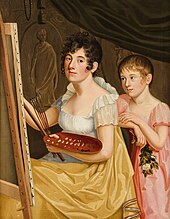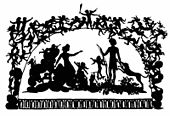Adele Schopenhauer

Luise Adelaide Lavinia Schopenhauer , known as Adele Schopenhauer (* July 12, 1797 in Hamburg , † August 25, 1849 in Bonn ), was a German writer. She was the sister of the philosopher Arthur Schopenhauer and daughter of the writer Johanna Schopenhauer and the merchant Heinrich Floris Schopenhauer. Henriette Sommer and Adrian van der Venne were pseudonyms used by her.
Live and act

Adele Schopenhauer grew up in Hamburg and stayed there during her parents' often long journeys. After her father's death in 1805, the family moved to Weimar the following year , where Adele grew up under the influence of the circle of artists and scholars that gathered in her mother's salon . Adele was gifted and engaged in literature and poetry. But she not only wrote fairy tales, poems and novels, she was also a master of paper cutting : both her outstanding paper cuttings and her literature have been recognized above all in the English-speaking world.
The loss of wealth in 1819
In May of 1819, Johanna and Adele Schopenhauer lost large parts of the assets they had inherited from Heinrich Floris Schopenhauer (Johanna's husband and father Adele) in 1805 when the Danzig bank Muhl collapsed, all of which they had deposited with the Danzig bank. Arthur Schopenhauer had only left a third of his fortune with Muhl and was also not prepared to enter into a comparison with Muhl. This affair led to a further deterioration in the relationship between Arthur and the two women, because they had repeatedly asked him in letters to agree to the settlement - not least because as women they were more dependent on interest income and hoped that the settlement would at least one more To be able to save some of the money. Mother and daughter therefore agreed to a comparison with a 70 percent loss and thus lost most of their assets. Arthur, however, refused to pay his bills, assuming the sister was trying to settle in order to get more secretly than him.
But the loss of wealth was not without decisive consequences. Johanna was able to earn something through her writing work and Adele had a small residual fortune because she was partially protected by her immaturity. But the lifestyle of mother and daughter Schopenhauer in the 20s of the 19th century did not by any means match those of the preceding years. This is also evident from a letter that Adele writes 17 years after the loss and in which she speaks of “pseudo-wealth”.
During those years Adele Schopenhauer was close friends with Goethe's future daughter-in-law Ottilie and consequently frequented Goethe's house in Weimar. It is said that she always called Goethe "father". This episode was later processed by Thomas Mann in his novel Lotte in Weimar .
Move to Bonn
Due to the change in conditions in Weimar and the less favorable financial situation, Adele and Johanna Schopenhauer considered moving. From 1827 Adele stayed more often in Cologne and Bonn. In May 1829 she moved permanently to Unkel near Bonn; in July the mother followed. In Bonn in 1828 she made friends with Sibylle Mertens-Schaaffhausen and Annette von Droste-Hülshoff - Adele described the latter as "the most witty being I know among women". A love affair developed between Sibylle Schaaffhausen and Adele Schopenhauer, which after several obstacles led to a relationship that would not end until Adele Schopenhauer's death.
Death and grave
After her mother's death in 1838, Adele published her estate and traveled extensively, mainly to Italy, until she returned to Bonn seriously ill with abdominal cancer. There she died as a result of the illness in 1849 and was buried on Goethe's 100th birthday in the old cemetery in Bonn, where her grave has been preserved to this day. Her friend and partner Sibylle Mertens-Schaaffhausen had a touching grave inscription made for her in Italian. Four days after Adele's funeral, Sibylle held a private funeral ceremony based on the ancient model in her garden on Wilhelmstrasse . 38 years after Adele's funeral, Sibylle's eldest daughter Auguste was also buried in the tomb at her own request.
Works
- Anna. A novel from the immediate past , part 1–2; Leipzig: Brockhaus, 1845 ( online - Internet Archive ).
- A Danish story ; Braunschweig: Westermann, 1848 ( online - Internet Archive ).
-
Poems and silhouettes , 2 volumes; ed. by HH Houben and Hans Wahl . Leipzig: Klinkhardt, 1920.
- Volume 1: Poems
- Volume 2: Paper cuts
- House, forest and fairy tales ; Leipzig: Brockhaus, 1844.
- Diary of a lonely ; ed. and introduced by HH Houben. With silhouettes by the author and an appendix by Rahel E. Feilchenfeldt-Steiner; Munich: Matthes & Seits Verlag, 1985.
- Florence. A travel guide with anecdotes and stories ; 1847/48; ed. by Waltraud Maierhofer. Weimar: VDG 2007.
- Vom-Niederrhein ; ed. by Ulrich Bornemann. Calendar for the Klever Land for the year 2009. Kleve 2008. pp. 99–117. ISBN 978-3-89413-009-1
Paper cutouts
literature
- Franz Brümmer: Schopenhauer, Adele . In: Allgemeine Deutsche Biographie (ADB). Volume 32, Duncker & Humblot, Leipzig 1891, p. 332 f.
- Anna Brandes: Adele Schopenhauer in the spiritual relationships in her time , Gelnhausen 1930, DNB 57186869X (Philosophical dissertation University of Frankfurt am Main 1930, 127 pages, 8 °).
- Gabriele Büch: All life is a dream. Adele Schopenhauer. A biography ; Berlin 2002, ISBN 3-7466-1797-9
- Domietta Seeliger: Adele Schopenhauer. Not just the philosopher's sister. Analysis of the narrative work by Adele Schopenhauer and the dramatic poem "Erlinde" by Wolfgang Maximilian von Goethe and Adele Schopenhauer (= European University Writings, Series 1, German Language and Literature , Volume 1901). Lang, Frankfurt am Main et al., 2004, ISBN 3-631-53227-X (Dissertation University of Perugia 2004, 223 pages).
- Karsten Hein: Ottilie von Goethe (1796–1872). Biography and literary relationships of Goethe's daughter-in-law (= European university publications. Series 1: German Language and Literature , Volume 1782). Peter Lang, Frankfurt am Main and others 2001, ISBN 3-631-37438-0 (Dissertation University of Düsseldorf 2000, 398 pages).
- Ilse Pohl: Miniatures - About Cornelia Goethe, Adele Schopenhauer, Clara Schumann and Annette von Droste-Hülshoff ; Publishing house of the Cornelia Goethe Academy, Frankfurt am Main, 2005; ISBN 3-933800-06-4
- Domietta Seeliger: Schopenhauer, Adele. In: New German Biography (NDB). Volume 23, Duncker & Humblot, Berlin 2007, ISBN 978-3-428-11204-3 , p. 473 f. ( Digitized version ).
- Angela Steidele : Story of a Love: Adele Schopenhauer and Sibylle Mertens ; Suhrkamp / Insel, Berlin and Frankfurt 2010 ISBN 978-3-458-17454-7
- Christina Ujma, Rotraut Fischer: “Florence is alive!”, Adele Schopenhauer, Fanny Lewald and the descriptions of Florence in pre- and post-March. In: Yearbook for International German Studies , Volume 40. Bern 2008, 2, pp. 85-104.
- Max Hecker : Ferdinand Heinke in Weimar . In: Goethe Yearbook . 47, 1927, pp. 251-306.
Web links
- Literature by and about Adele Schopenhauer in the catalog of the German National Library
- Works by Adele Schopenhauer in the Gutenberg-DE project
- Works by Adele Schopenhauer at Zeno.org .
- Adele Schopenhauer in the Internet Archive
- Poems in full text
- Christa Bürger : The erotomaniac who doesn't dare: The failed life of Adele Schopenhauer , contribution from June 9, 2013 in the series Essay and Discourse of Deutschlandfunk ( mp3 , 26 MB, approx. 29 min.)
Individual evidence
- ↑ Some of her paper cuttings are shown at scherenschnitt.org .
- ↑ A letter from Adele to Arthur dated November 22, 1819 illustrates the tense atmosphere impressively. He closes with the following words: “You feel my terrible situation, so don't upset me if I am now unable to write more. Just give me news from you soon - but I ask you seriously, don't irritate me with mistrust now. I am so sore, depressed and have so various painful tears to deal with myself in silence that I cannot bear anything more. Suspicion has never been part of what I endured, even the slightest hint separates us. I have your firmness, but I also have your pride, don't forget that. "(From: Gwinner, Schopenhauer's life )
- ↑ Angela Steidele: Story of a love. Adele Schopenhauer and Sibylle Mertens. Suhrkamp / Insel, Berlin and Frankfurt 2010, p. 52.
- ↑ Steidele 2010, p. 53.
- ↑ Adele wrote to Arthur in 1836: “I endured years of agony; because my loss of wealth has broken, ruined all noble, more beautiful circumstances, botched my life, because I lived as if I were wealthy and yet could not marry out of poverty and because the pseudo-wealth oppressed me like a lie. "(Gwinner, Schopenhauers Leben , p . 200)
- ↑ Domietta Seeliger: Schopenhauer, Adele. In: New German Biography (NDB). Volume 23, Duncker & Humblot, Berlin 2007, ISBN 978-3-428-11204-3 , p. 473 f. ( Digitized version ).
- ↑ Steidele 2010, p. 281.
- ↑ in a letter about her visit to Droste in Haus Rüschhaus
- ↑ See Steidele 2010, passim.
- ↑ Adele comments on the move to Bonn as follows: “I found a woman here on the Rhine who became very dear to me. She did a lot for me and, no doubt, saved me. We did not come here for her, however; The effort in Weimar had been too great, there were debts that were covered with very great sacrifices on my part, and it was necessary to live from another starting point, to have new circumstances, for economic reasons. In addition there was the climate which in Weimar required the mother to take annual bathing trips, which were useless here, which was a saving. At last the memories weighed heavily on me. I liked to go. The ducal family died, the fate of many friends changed, they moved away and Weimar could no longer captivate us, although it remains unforgettable to us. "(Gwinner, Schopenhauers Leben , p. 387)
- ↑ Edith Ennen among others: The old cemetery in Bonn. History, biographical, art and intellectual history . City of Bonn, 5th, reviewed edition 1986, ISBN 3-922832-03-2 , p. 59.
| personal data | |
|---|---|
| SURNAME | Schopenhauer, Adele |
| ALTERNATIVE NAMES | Schopenhauer, Luise Adelaide Lavinia (full name); Sommer, Henriette (pseudonym); Venne, Adrian van der (pseudonym) |
| BRIEF DESCRIPTION | German writer and silhouette artist |
| DATE OF BIRTH | July 12, 1797 |
| PLACE OF BIRTH | Hamburg |
| DATE OF DEATH | August 25, 1849 |
| PLACE OF DEATH | Bonn |







